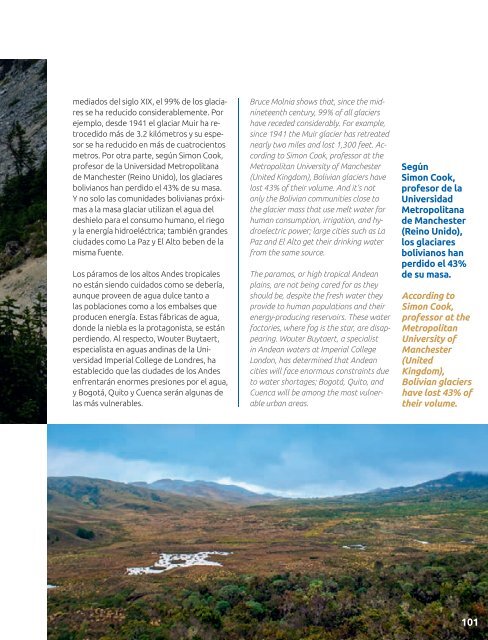Create successful ePaper yourself
Turn your PDF publications into a flip-book with our unique Google optimized e-Paper software.
mediados del siglo XIX, el 99% de los glaciares<br />
se ha reducido considerablemente. Por<br />
ejemplo, desde 1941 el glaciar Muir ha retrocedido<br />
más de 3.2 kilómetros y su espesor<br />
se ha reducido en más de cuatrocientos<br />
metros. Por otra parte, según Simon Cook,<br />
profesor de la Universidad Metropolitana<br />
de Manchester (Reino Unido), los glaciares<br />
bolivianos han perdido el 43% de su masa.<br />
Y no solo las comunidades bolivianas próximas<br />
a la masa glaciar utilizan el agua del<br />
deshielo para el consumo humano, el riego<br />
y la energía hidroeléctrica; también grandes<br />
ciudades como La Paz y El Alto beben de la<br />
misma fuente.<br />
Los páramos de los altos Andes tropicales<br />
no están siendo cuidados como se debería,<br />
aunque proveen de agua dulce tanto a<br />
las poblaciones como a los embalses que<br />
producen energía. Estas fábricas de agua,<br />
donde la niebla es la protagonista, se están<br />
perdiendo. Al respecto, Wouter Buytaert,<br />
especialista en aguas andinas de la Universidad<br />
Imperial College de Londres, ha<br />
establecido que las ciudades de los Andes<br />
enfrentarán enormes presiones por el agua,<br />
y Bogotá, Quito y Cuenca serán algunas de<br />
las más vulnerables.<br />
Bruce Molnia shows that, since the midnineteenth<br />
century, 99% of all glaciers<br />
have receded considerably. or eamle,<br />
since 1941 the Muir glacier has retreated<br />
nearly two miles and lost 1,300 feet. According<br />
to Simon Cook, professor at the<br />
etroolitan niversity of anchester<br />
(nited ingdom), olivian glaciers have<br />
lost of their volume. nd its not<br />
only the olivian communities close to<br />
the glacier mass that use melt water for<br />
human consumption, irrigation, and hydroelectric<br />
power; large cities such as La<br />
Paz and El Alto get their drinking water<br />
from the same source.<br />
The paramos, or high tropical Andean<br />
plains, are not being cared for as they<br />
should be, despite the fresh water they<br />
rovide to human oulations and their<br />
energyroducing reservoirs. hese water<br />
factories, where fog is the star, are disappearing.<br />
Wouter Buytaert, a specialist<br />
in ndean waters at Imerial ollege<br />
London, has determined that Andean<br />
cities will face enormous constraints due<br />
to water shortages; Bogotá, Quito, and<br />
uenca will be among the most vulnerable<br />
urban areas.<br />
Según<br />
Simon Cook,<br />
profesor de la<br />
Universidad<br />
Metropolitana<br />
de Manchester<br />
(Reino Unido),<br />
los glaciares<br />
bolivianos han<br />
perdido el 43%<br />
de su masa.<br />
According to<br />
Simon Cook,<br />
professor at the<br />
Metropolitan<br />
University of<br />
Manchester<br />
(United<br />
Kingdom),<br />
Bolivian glaciers<br />
have lost 43% of<br />
their volume.<br />
101



